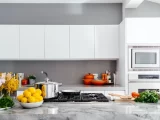The Beauty of Minimalism in Interior Design
February 2, 2024Minimalism is an evergreen interior design trend that never goes out of style. This approach to space design focuses on creating tranquil environments through clean lines, neutral palettes, and well-curated details.
Minimalism may have the reputation of creating cold and stark interiors, but there are ways you can add warmth through natural elements like wood. Read on for our tips to bring minimalism into your home!
1. Less is More
Minimalism has quickly become one of the hottest trends in interior design due to its ability to create peaceful environments that promote balance and harmony. This style features clean lines with neutral color palettes for optimal visual effect.
Attain this by selecting materials such as marble and wood that exude elegance or going for more subdued colors such as whites and creams to establish a neutral base.
2. Natural Light
Minimalism places great importance on natural light. Minimalist designers typically choose large windows and reflective surfaces to maximize sunlight – this not only makes a room appear larger but can reduce electricity costs considerably.
Minimalist design provides an oasis of calm in our otherwise chaotic lives, helping us focus on what truly matters while creating serene living environments.
3. Embrace Negative Space
Negative space may seem counterintuitive when decorating, yet this essential component of minimalism makes your designs more visually appealing.
Negative space refers to any empty area around and between furniture pieces that enables each to take center stage without becoming lost amid other decor. Furthermore, negative space creates visual breathing room and stops rooms from feeling too cramped.
4. Invest in Quality Over Quantity
Finding high-quality furniture and decor pieces that complement minimalism is paramount to its success. Items should feature sleek lines, easy maintenance requirements and exude an overall sense of purity and simplicity.
Minimalism is an ever-evolving style that works beautifully in any home, thanks to its focus on essential design elements. Minimalist styles will never go out of fashion!
No matter your reason for exploring minimalism in design, or just want to know more, get in touch with us now. Our interior design services can help you craft the ideal space.
5. Focus on Function
Minimalism is a design style that emphasizes functionality, placing special importance on storage solutions such as built-in cabinets and hidden nooks for keeping spaces organized and bright. Minimalists also prioritize optimizing natural light to keep living areas open and airy.
Minimalists tend to favor furniture that features clean lines and geometric forms. Rounder pieces provide softening effects to contrast with minimalism’s rigid, sharp lines, while home accents such as greenery or artwork should complement rather than detract from this theme.
6. Create a Focal Point
Focus points are important because they draw the eye and create a sense of balance and harmony within any space, adding personality without taking over completely.
Minimalism is defined by its emphasis on symmetry and clean lines, yet scale is equally as crucial – objects which are too large or small can make the design unbalanced and throw it off balance.
New minimalist designs incorporate more natural elements, such as rounded shapes and caramel-colored woods to give minimalism an elegant and timeless aesthetic.
7. Incorporate Texture
Interior minimalism focuses on eliminating unnecessary items to achieve functional yet beautiful spaces. Through decluttering, accepting negative space, selecting neutral color palettes and natural materials and prioritizing function over aesthetics minimalism helps design spaces that are both beautiful and useful.
Though minimalist styles were once defined by furniture with clean lines and geometric forms, many designers are experimenting with various textures in order to add warmth and an organic touch to a space – wood being one of the most popular materials used.
8. Choose Neutral Colors
Neutral colors offer timeless sophistication that stands the test of time, as well as providing versatility that allows other elements in your design to stand out and add depth and dimension.
Minimalism typically employs neutral colors to create soothing and serene spaces, making the ideal atmosphere. To keep clutter at a minimum, creating storage solutions and organization systems ensure only necessary items are displayed on surfaces.
9. Incorporate Wood
Wood is a timeless design element that adds warmth and coziness to a home, as well as being eco-friendly if it is properly cared for.
Whatever style you are after – warm minimalism or more contemporary spaces – minimalism can easily fit into any interior design scheme. By stripping down to essentials and choosing an appealing color palette, minimalism creates a healthy and visually-pleasing space for living and work environments alike.





